Alfred Jarry
Alfred Jarry (French: [al.fʁɛd ʒa.ʁi]; 8 September 1873 – 1 November 1907) was a French symbolist writer who is best known for his play Ubu Roi (1896),[1] a pataphysical work which depicts the bourgeoisie as the super-mediocre. He coined the term and philosophical concept of pataphysics, which uses absurd irony to portray symbolic truths (and playfully vice versa).[2]
Alfred Jarry | |
|---|---|
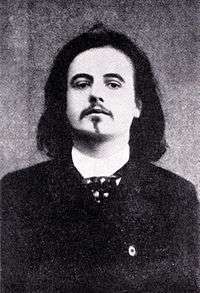 | |
| Born | 8 September 1873 Laval, Mayenne, France |
| Died | 1 November 1907 (aged 34) Paris, France |
| Occupation | Writer and dramatist |
| Nationality | French |
| French literature |
|---|
| by category |
| French literary history |
| French writers |
|
| Portals |
|
Jarry was born in Laval, Mayenne, France, and his mother was from Brittany.[3] He was associated with the Symbolist movement. His play Ubu Roi is often cited as a forerunner of Dada and the Surrealist and Futurist movements of the 1920s and 1930s. He wrote in a variety of hybrid genres and styles, prefiguring the postmodern, including novels, poems, short plays and opéras bouffes, absurdist essays and speculative journalism. His texts are considered examples of absurdist literature and postmodern philosophy.
Biography and works
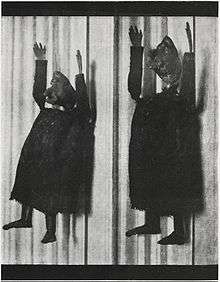
His father Anselme Jarry (1837-1895) was a salesman who descended into alcoholism; his mother Caroline, née Quernest (1842-1893), was interested in music and literature, but her family had a streak of insanity, and her mother and brother were institutionalized. The couple had two surviving children, a daughter Caroline-Marie, called Charlotte (1865-1925), and Alfred. In 1879 Caroline left Anselme and took the children to Saint-Brieuc in Brittany.[4]
In 1888 the family moved to Rennes, where Jarry entered the lycée at 15. There he led a group of boys who enjoyed poking fun at their well-meaning, but obese and incompetent physics teacher, a man named Hébert. Jarry and his classmate, Henri Morin, wrote a play they called Les Polonais and performed it with marionettes in the home of one of their friends. The main character, Père Heb, was a blunderer with a huge belly, three teeth (one of stone, one of iron and one of wood), a single, retractable ear and a misshapen body. In Jarry's later work Ubu Roi, Père Heb would develop into Ubu, one of the most monstrous and astonishing characters in French literature.
At 17 Jarry passed his baccalauréat and moved to Paris to prepare for admission to the École Normale Supérieure. Though he was not admitted, he soon gained attention for his original poems and prose-poems. A collection of his work, Les minutes de sable mémorial, was published in 1893.
That same year, Jarry contracted influenza. His mother and sister tended him, but once he recovered his mother fell ill of the disease and died; two years later his father perished from influenza as well, leaving Jarry a small inheritance which he quickly spent.[5]
Jarry had meantime discovered the pleasures of alcohol, which he called "my sacred herb" or, when referring to absinthe, the "green goddess." A story is told that he once painted his face green and rode through town on his bicycle in its honour (and possibly under its influence).
When he was drafted into the army in 1894, his gift for turning notions upside down defeated attempts to instill military discipline. The sight of the small man in a uniform much too large for his less than 5-foot frame—the army did not issue uniforms small enough—was so disruptively funny that he was excused from parades and marching drills. Eventually the army discharged him for medical reasons. His military experience eventually inspired his novel Days and Nights.
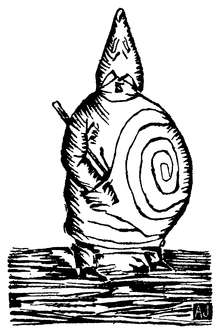
Jarry returned to Paris and applied himself to writing, drinking and the company of friends who appreciated his witty, sweet-tempered and unpredictable conversation. This period is marked by his intense involvement with Remy de Gourmont in the publication of L'Ymagier , a luxuriously produced "art" magazine devoted to the symbolic analysis of medieval and popular prints. Symbolism as an art movement was in full swing at this time, and L'Ymagier provided a nexus for many of its key contributors. Jarry's play Caesar Antichrist (1895) drew on this movement for material. This is a work that bridges the gap between serious symbolic meaning and the type of critical absurdity with which Jarry would soon become associated. Using the biblical Book of Revelation as a point of departure, Caesar Antichrist presents a parallel world of extreme formal symbolism in which Christ is resurrected not as an agent of spirituality but as an agent of the Roman Empire that seeks to dominate spirituality. It is a unique narrative that effectively links the domination of the soul to contemporaneous advances in the field of Egyptology such as the 1894 excavation of the Narmer Palette, an ancient artifact used for situating the rebus within hermeneutics. The character Ubu Roi first appears in this play.[6]
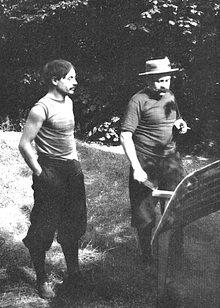
The spring of 1896 saw the publication, in Paul Fort's review Le Livre d'art, of Jarry's 5-act play Ubu Roi, the rewritten and expanded Les Polonais of his school days. Ubu Roi's savage humor and monstrous absurdity, unlike anything thus far performed in French theater, seemed unlikely to ever actually be performed on stage. However, impetuous theater director Aurélien-Marie Lugné-Poe took the risk, producing the play at his Théâtre de l'Œuvre.
On opening night (10 December 1896), with traditionalists and the avant-garde in the audience, King Ubu (played by Firmin Gémier) stepped forward and intoned the opening word, "Merdre!" (often translated as "Pshit" or "Shittr!" in English). A quarter of an hour of pandemonium ensued: outraged cries, booing, and whistling by the offended parties, countered by cheers and applause by the more degenerate contingent. Such interruptions continued through the evening. At the time, only the dress rehearsal and opening night performance were held, and the play was not revived until after Jarry's death.
The play brought fame to the 23-year-old Jarry, and he immersed himself in the fiction he had created. Gémier had modeled his portrayal of Ubu on Jarry's own staccato, nasal vocal delivery, which emphasized each syllable (even the silent ones). From then on, Jarry would always speak in this style. He adopted Ubu's ridiculous and pedantic figures of speech; for example, he referred to himself using the royal we, and called the wind "that which blows" and the bicycle he rode everywhere "that which rolls."
Jarry moved into a flat which the landlord had created through the unusual expedient of subdividing a larger flat by means of a horizontal rather than a vertical partition. The diminutive Jarry could just manage to stand up in the place, but guests had to bend or crouch. Jarry also took to carrying a loaded revolver. In response to a neighbor's complaint that his target shooting endangered her children, he replied, "If that should ever happen, ma-da-me, we should ourselves be happy to get new ones with you."
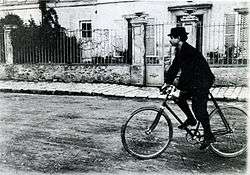
With Franc-Nohain and Claude Terrasse he co-founded the Théatre des Pantins, which in 1898 was the site of marionette performances of Ubu Roi.[7]
Living in worsening poverty, neglecting his health and drinking excessively, Jarry went on to write the novel Le Surmâle (The Supermale), which is partly a satire on the Symbolist ideal of self-transcendence.
Unpublished until after his death, his fiction Exploits and Opinions of Dr. Faustroll, Pataphysician (Gestes et opinions du docteur Faustroll, pataphysicien) describes the exploits and teachings of a sort of antiphilosopher who, born at age 63, travels through a hallucinatory Paris in a sieve and subscribes to the tenets of 'pataphysics. 'Pataphysics deals with "the laws which govern exceptions and will explain the universe supplementary to this one." In 'pataphysics, every event in the universe is accepted as an extraordinary event.
Jarry once wrote, expressing some of the bizarre logic of 'pataphysics, "If you let a coin fall and it falls, the next time it is just by an infinite coincidence that it will fall again the same way; hundreds of other coins on other hands will follow this pattern in an infinitely unimaginable fashion."
In his final years, he was a legendary and heroic figure to some of the young writers and artists in Paris. Guillaume Apollinaire, André Salmon and Max Jacob sought him out in his truncated apartment. Pablo Picasso was fascinated with Jarry.[8] After Jarry's death Picasso acquired his revolver and wore it on his nocturnal expeditions in Paris. He later bought many of his manuscripts as well as executing a fine drawing of him.
Jarry died in Paris on 1 November 1907 of tuberculosis, aggravated by drug and alcohol use. When he could not afford alcohol, he drank ether.[9] It is recorded that his last request was for a toothpick. He was interred in the Cimetière de Bagneux, near Paris.
The complete works of Alfred Jarry are published in three volumes by Gallimard in the collection Bibliothèque de la Pléiade.
Selected Jarry works
Plays
- César-Antéchrist (1895) - (Caesar Antichrist) – which introduces Père Ubu and his symbolic meaning.
- Ubu Roi (1896, revised from 1888) - (Ubu Rex) – which portrays the ambition of Père Ubu.
- Ubu Cocu, ou l'Archeopteryx (1897) - (Ubu Cuckolded) - which portrays the inconstancy of Ubu's closest.
- Ubu Enchaíné (1899) - (Ubu in Chains) – which portrays Père Ubu in service.
- Ubu Sur La Butte (1906)
Novels
- Les Jours et Les Nuits, roman d'un déserteur (1897) - (Days and Nights, novel of a deserter). The first part of a fictional (or pataphysical) autobiography of life in the army.
- L'Amour en Visites (1897) - (Love in Visits). The second part of a fictional (or pataphysical) autobiography of life and the theatre.
- L'Amour Absolu (1899) - (Absolute Love). The third and final part of this autobiography.
- Messaline (1900) - (Messalina) – set in ancient Rome.
- Le Surmâle (1902) - (The Supermale) - features a superhuman bicycle race in which the hero is propelled by perpetual motion food (alcohol).
- Gestes et Opinions du Docteur Faustroll, Pataphysicien (Exploits and Opinions of Dr. Faustroll, Pataphysician) – published posthumously in 1911. This novel's symbolism defines the symbolic meaning of pataphysique.
- La Dragonne – assembled and published posthumously in 1943.
Other notable works
- Short story La Passion considérée comme course de côte (The Passion Considered as an Uphill Bicycle Race) has been widely circulated and imitated, notably by J. G. Ballard and Robert Anton Wilson.
- Comic operetta The Pope's Mustard-Maker (Le Moutardier du pape) First English translation (2019) by Doug Skinner.
- Les Minutes de Sable Memorial (1894) - (Minutes of Memorial Sand) – a collection of short early works including the symbolist play Haldernablou.
- La Chandelle Verte: Lumières sur les Choses de ce Temps - (The Green Candle) – a collection of absurdist essays which revert his pataphysique the other way round. They address contemporary issues in an absurd manner. Originally published in reviews and collected in 1969.
- Illustrated Almanac of Père Ubu (1899).
- Illustrated Almanac of Père Ubu - 2nd edition (1901). Both the 1899 and 1901 almanacs are downloadable (in French) at http://alfredjarry.fr/jarry/
Bibliography
- Beaumont, Keith (1984). Alfred Jarry: A Critical and Biographical Study. U.S.: St. Martin's Press. ISBN 0-312-01712-X.
- Fell, Jill (2005). Alfred Jarry. An Imagination in Revolt. U.S.: Fairleigh Dickinson University Press. ISBN 0-8386-4007-9.
- Fell, Jill (2010). Alfred Jarry. London, Reaktion Books. ISBN 978-1-86189-755-8.
- Brotchie, Alastair (2011). Alfred Jarry: A Pataphysical Life. U.S.: The MIT Press. ISBN 978-0-262-01619-3.
- Lennon, Nigey (1984). Alfred Jarry: The Man with the Axe. U.S.: Last Gasp. ISBN 0-86719-382-4.
- Tomkins, Calvin (1996). Duchamp: A Biography. U.S.: Henry Holt and Company. ISBN 0-8050-5789-7.
- Shattuck, Roger (1958). The Banquet Years: the Arts in France, 1885–1918: Alfred Jarry, Henri Rousseau, Erik Satie, Guillaume Apollinaire. U.S.: Henry Holt and Company. ISBN 0-394-70415-0.
- Dubbelboer, M (2009), "Ubusing" culture: Alfred Jarry's subversive poetics in the Almanachs du Père Ubu (Thesis/dissertation)
|format=requires|url=(help), ISBN 978-90-367-4040-1 - Stillman, Linda Klieger (1980). La Theatralité dans l'Œuvre d'Alfred Jarry. U.S.: French Literature Publications Company. ISBN 0-917786-12-2
- Stillman, Linda Klieger (1983). Alfred Jarry. U.S.: Twayne Publishers, ISBN 0-8057-6528-X.
References
- Jarry, Alfred. "Ubu Roi". Dover (2003)
- "Pataphysics - 01 edition"
- Brotchie, Alastair. Alfred Jarry, a Pataphysical Life. MIT Press (2013). ISBN 978 0 262 01619 3
- Lennon, Nigey. Alfred Jarry: The Man with the Axe. San Francisco: Last Gasp, 1984, pp. 16-18. ISBN 0-86719-382-4
- Lennon, Nigey. Alfred Jarry: The Man with the Axe, pp. 34, 61.
- Cody, Gabriele. Sprinchorn, Everet. The Columbia Encyclopedia of Modern Drama, Volume 1. Columbia University Press (2007) ISBN 9780231144223 page 53
- PADA, Schubertiade Music Online
- "5 Things You Didn't Know About Pablo Picasso". The Huffington Post. 8 April 2015. Retrieved 3 May 2016.
- "The King of Charisma". The New York Review of Books. 10 May 2012.
External links



- Works by Alfred Jarry at Project Gutenberg
- Works by or about Alfred Jarry at Internet Archive
- Works by Alfred Jarry at LibriVox (public domain audiobooks)

- Alfred Jarry at Find a Grave
- Ubu Roi ou Les Polonais at athena.unige.ch (in French)